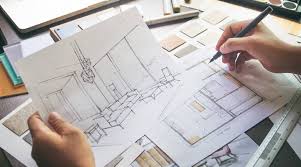The first order of business is purchasing a lot. A truly custom home design is specifically designed for the lot it sits on. Please read EzineArticles online article “Buying a Lot to Get a Custom Home Designed” for what to consider. A survey will be needed before the custom home design can begin. If it is an older property there should be one in the closing documents.
Now there is some home design homework to do even before purchasing a lot. You have to know what you desire in the home and what the footage goal is to know what size the lot has to be.
This homework is the first step in the house design. No matter how talented the designer they are dependent on you for it to be a custom design with communication being the key. So do not be shy about providing whatever you have accumulated or generated whether it be pictures, notes, spreadsheets or anything else that helps present what you want. Whether you provide a lot of material or none at all though it is the designers responsibility to discuss anything relevant to the project.
The initial design conference meeting(s) will be to completely define your dream home.
The footage will determine the cost more than anything else and should be the first consideration. How many stories and what exterior style and finish material needs to be defined. Each room should be discussed to determine the size, raised ceilings, flooring or any other features. The first factor in determining room locations is what view they will have. If there is a stunning rear view only so many rooms can take advantage of then these rooms need to be defined. A stairs if any often has expectations that go with it whether it is the railing, finish or location. If it is viewed as more of a functional need then a location requiring less expense in finishing than a foyer might be considered. Will the house be open concept so that the family room, breakfast and kitchen are open to each other. All aspects of the kitchen should be defined. Especially if there will be an island and all appliances and their locations. It is often helpful to know what the current kitchen cabinet footage is to ensure equal or greater cabinet footage. Does there need to be a private desk area off the kitchen for paying bills. Would a backpack, hobby or sports storage area with cabinets off the garage be helpful. All features of the utility room including a built in ironing board need to be considered. If there is a pool does there need to be a pool bath or can the powder room be located near the rear. Is the master bath to be more functional or luxurious or something in between. How many bathrooms. Will there be a game room, study, hobby room or other rooms not considered a given. Are art niches or ledges desired. This is a minimum necessary to start a design drawing.
If the due diligence has not been this thorough then there is a good chance you will not get your dream home design. No matter how creative it is if it is not what you imagined then it is a failed design. I am not suggesting taking away creative freedom only that any expectations have to be communicated. Make sure the designer is asking all the right questions or make sure you volunteer them. Alternatively just consider another designer because it is hard to correct a design that heads down the wrong path.
Only when the scope of the design has been completely defined should the design drawing begin. The primary goal should be to meet the design criteria in the most space efficient way possible while being creative.
The next meeting will be to review the preliminary design which typically consist of the floor plans without all the construction details, the front elevation and the plot plan showing the house located on the lot.
This is the first time to really know if you are on the same page as your designer. That is why the due diligence was so critical. Hopefully any revisions will be minimal but most importantly none will cause a compromise to the design. Sometimes even with all the necessary communication the design is still not what was expected. Unfortunately this is often do to the designer substituting their preferences. That is another reason to define what is expected. If it was discussed there is no excuse that it was never communicated. Stand your ground even if it means starting the design over.
A designer has a responsibility to a client to inform them if they think they are making a mistake. Once the client knows why you are concerned hopefully they will agree. It is never acceptable to just ignore a clients wishes or substitute your own preferences.
This preliminary design meeting is also the time to discuss in depth details like lighting, cabinet styles and finishes if it has not been done. If the revisions are such that it would be prudent to review the preliminary again once they are done that would be the next step. If any revisions are minor then the design is ready to be finalized.

